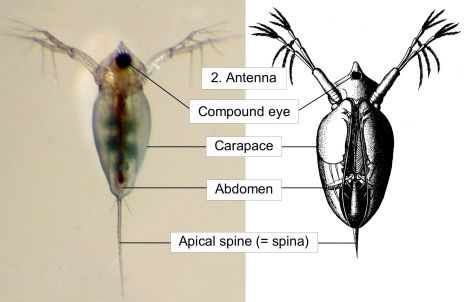Adaptation
The Daphnia pulex has
acquired many characteristics in order to adapt to its
environment. Many of these characteristics are structural and
have to do with the organism’s morphology, while others have to
do more with the behavior of the organism.

Because the Daphnia pulex is denser than the water it lives in,
it has
developed a unique way in which it moves in order to avoid
sinking to the bottom of its freshwater environment. The
organism
uses its muscles to beat the second set of antennae, which
actually pushes them through the water. This “hopping”
motion is actually where they obtained the common name of the water
flea due to similar movement to that of the terrestrial flea.
When Daphnia are in more of a sedentary mood or are in need of a
good meal, they can then put those appendages at rest and roam
around the muddy bottom in search for food particles.
The Daphnia pulex has
also acquired many sensory adaptations to be able to respond to
its aquatic environment. The nervous system consists of a
primitive layout of nerves to the ganglion. This water flea also
has
developed a compound eye to help it sense its surroundings
of the aquatic habitat. In addition, they also have a
light-sensing organ similar to that of a tiny eye called an ocellus.
This above photo clearly indicates one of D. pulex's
sensory structures, the compound eye.
Another
incredible adaptation among D. pulex includes their ability to
actually change form in presence of a predator in order to be a
less suitable food source. This is called cyclomorphosis. A
decrease in size is often common when the adult fish populations
are high. This adaptation makes it difficult for the larger
organisms to spot the little creatures hopping along in the
water. In addition, Daphnia will often increase in size when the
young population of fish is more abundant, making it more
difficult for the smaller fish to eat.
Lastly, one
of the main adaptations to its environment Daphnia have
developed is its ability to alternate between sexual and asexual
reproduction, as mentioned earlier when discussing the life
cycle. Remember, asexual reproduction includes the female
reproduction process of parthenogenesis. This is when the female
simply makes clones of itself without any fertilization of eggs.
However, when conditions are unfavorable to Daphnia, the
organism actually chooses to undergo sexual reproduction. In
this case, male Daphnia and female Daphnia are both produced.
When the male matures, he can then fertilize the female’s eggs
which are encased in tough shells that can resist many severe
weather conditions. This is an incredible adaptation the water
flea has made to its tough environment!
Find out about what the organism eats.
Go back home.
